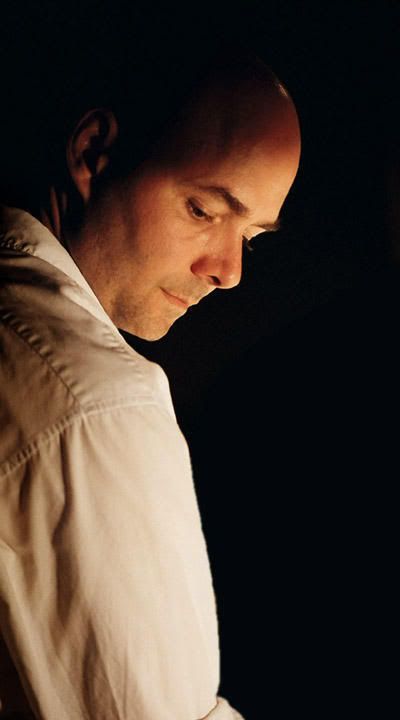 Bret Wood is a 42-year-old filmmaker in Atlanta, Georgia. In addition to Psychopathia Sexualis, he directed Hell's Highway: The True Story of Highway Safety Films, which documented the gruesome "death-on-the-highway" educational films made in the U.S. in the 1960s. Bret is the co-author (with Felicia Feaster) of Forbidden Fruit: The Golden Age of the Exploitation Film, and compiled the books Queen Kelly: The Complete Screenplay by Erich von Stroheim and Marihuana, Motherhood & Madness: Three Screenplays from the Exploitation Cinema of Dwain Esper. His essays have appeared in Sight and Sound, Film Comment, Positif, Video Watchdog, and Filmfax. He produces DVDs for Kino International and is currently finishing special editions of F.W. Murnau's Nosferatu and Robert Wiene's The Hands of Orlac.
Bret Wood is a 42-year-old filmmaker in Atlanta, Georgia. In addition to Psychopathia Sexualis, he directed Hell's Highway: The True Story of Highway Safety Films, which documented the gruesome "death-on-the-highway" educational films made in the U.S. in the 1960s. Bret is the co-author (with Felicia Feaster) of Forbidden Fruit: The Golden Age of the Exploitation Film, and compiled the books Queen Kelly: The Complete Screenplay by Erich von Stroheim and Marihuana, Motherhood & Madness: Three Screenplays from the Exploitation Cinema of Dwain Esper. His essays have appeared in Sight and Sound, Film Comment, Positif, Video Watchdog, and Filmfax. He produces DVDs for Kino International and is currently finishing special editions of F.W. Murnau's Nosferatu and Robert Wiene's The Hands of Orlac.
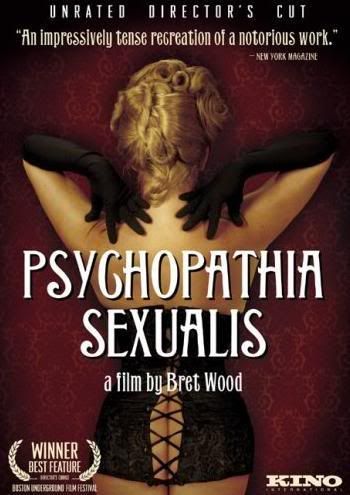 I corresponded with Bret following my Honourable Mention of Psychopathia Sexualis, with regards the film, which shot immediately into my all time favourite film list, and he has kindly agreed to be interviewed for Taliesin Meets the Vampires.
I corresponded with Bret following my Honourable Mention of Psychopathia Sexualis, with regards the film, which shot immediately into my all time favourite film list, and he has kindly agreed to be interviewed for Taliesin Meets the Vampires.
More information about Bret’s work can be found at the film’s homepage, Illustrated Films and at Bret’s MySpace profile.
 Thank you for taking time to look at my questions. Your film Psychopathia Sexualis is based on both the medical text of the same name and the “Text Book of Insanity’, what drew you to write a script based on these 19th century texts?
Thank you for taking time to look at my questions. Your film Psychopathia Sexualis is based on both the medical text of the same name and the “Text Book of Insanity’, what drew you to write a script based on these 19th century texts?
 I had originally read Psychopathia Sexualis as research for another project I chose not to pursue. But I found myself more interested in Krafft-Ebing's work than the screenplay I was developing. I was fascinated by the sheer weirdness of the book's case histories, but more importantly, I was intrigued by the way in which Krafft-Ebing treated them. As if he were determined not to be shocked by these cases of sadism, masochism and fetishism (bizarre even by today's standards), he categorized and described the cases with cold, clinical detachment. But his Victorian attitudes would occasionally show through, and there are moments of disgust and moral judgement. So I liked this book that was at odds with itself. And so I tried to make a film that was, at times, at odds with itself.
I had originally read Psychopathia Sexualis as research for another project I chose not to pursue. But I found myself more interested in Krafft-Ebing's work than the screenplay I was developing. I was fascinated by the sheer weirdness of the book's case histories, but more importantly, I was intrigued by the way in which Krafft-Ebing treated them. As if he were determined not to be shocked by these cases of sadism, masochism and fetishism (bizarre even by today's standards), he categorized and described the cases with cold, clinical detachment. But his Victorian attitudes would occasionally show through, and there are moments of disgust and moral judgement. So I liked this book that was at odds with itself. And so I tried to make a film that was, at times, at odds with itself.
 Looking at the story of JH for a moment, what drew you to that specific case study?
Looking at the story of JH for a moment, what drew you to that specific case study?
 The J.H. case beautifully represents 90% of the cases in the book Psychopathia Sexualis. When people are being repressed by society, and not allowed to express their sexual feelings freely, they find other ways to explore these desires. Maybe it wasn't so clear in the 1880s, but in hindsight, that is the obvious source of so many of the book's cases of "deviance." I guess the more polite modern term would be "transference." J.H. was dominated by his mother, was stuck in a state of frustrated adolescence, and had no way to experience sexual pleasure.
The J.H. case beautifully represents 90% of the cases in the book Psychopathia Sexualis. When people are being repressed by society, and not allowed to express their sexual feelings freely, they find other ways to explore these desires. Maybe it wasn't so clear in the 1880s, but in hindsight, that is the obvious source of so many of the book's cases of "deviance." I guess the more polite modern term would be "transference." J.H. was dominated by his mother, was stuck in a state of frustrated adolescence, and had no way to experience sexual pleasure. 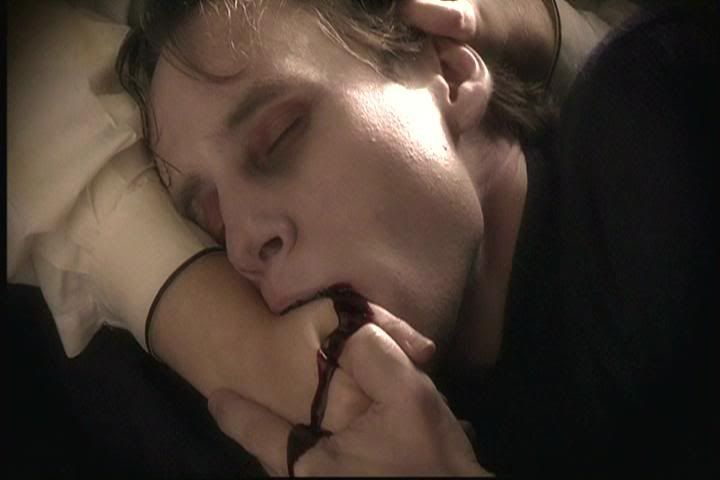 When one of his mother's maids cut her hand, and he went to help her, J.H. found himself suddenly in a very intimate position with the maid. I emphasized this (and his childlike state) by having him curling into a fetal position and suckling on her bleeding hand. So, J.H. found a way to be sexual after all, while abiding by the Victorian code of premarital abstinence.
When one of his mother's maids cut her hand, and he went to help her, J.H. found himself suddenly in a very intimate position with the maid. I emphasized this (and his childlike state) by having him curling into a fetal position and suckling on her bleeding hand. So, J.H. found a way to be sexual after all, while abiding by the Victorian code of premarital abstinence.
Originally his sequence was to be relatively short, but the more I thought about his case, more layers of meaning began to rise to the surface, and so I kept expanding his story and shooting additional scenes. In hindsight, I kind of regret not making the film JUST about J.H., instead of blending so many other case histories. In a recent review, Sight and Sound, Tim Lucas wrote, "the vampire study is rich and unusual, full of haunting images, and could have made a strong, genre-advancing feature in its own right." There's no reason I couldn't return to the story one day, and spend more time developing its multi-layered meanings.
 There is a scene of JH creeping down the stairs that, to me, was reminiscent of Murnau’s Nosferatu or perhaps even Weine. Also the Chicago Tribune likened aspects of the film to Lang. Was there a deliberate attempt to capture the feel of those directors, and what was the reason behind this?
There is a scene of JH creeping down the stairs that, to me, was reminiscent of Murnau’s Nosferatu or perhaps even Weine. Also the Chicago Tribune likened aspects of the film to Lang. Was there a deliberate attempt to capture the feel of those directors, and what was the reason behind this?
 I am mostly influenced by silent filmmakers, especially Murnau, but also Lang, Wiene, Leni, Dreyer, and films such as Arthur Robisons's Warning Shadows (Schatten) and Benjamin Christensen's Haxan: Witchcraft Through the Ages. I wanted to pay homage to these filmmakers, but I didn't want to just "quote" them or create a pastiche of scenes ripped off from their films. I just tried my best to speak their language.
I am mostly influenced by silent filmmakers, especially Murnau, but also Lang, Wiene, Leni, Dreyer, and films such as Arthur Robisons's Warning Shadows (Schatten) and Benjamin Christensen's Haxan: Witchcraft Through the Ages. I wanted to pay homage to these filmmakers, but I didn't want to just "quote" them or create a pastiche of scenes ripped off from their films. I just tried my best to speak their language.
 The inspiration of some shots is obvious (like the shot you mentioned of J.H. walking down the stairs, which owes its origins to Nosferatu and Caligari). But other scenes are less obvious tributes, and weren't always inspired by specific films of the silent era, but the overall style and tone. And I resisted the urge to filter and dirty the image to make a faux-silent movie that looks old. Rather than deny myself the modern technologies of digital video, with color and sound, I embraced them. I just chose to resist the modern screen language of hand-held camera, fast-cutting and a hard rock soundtrack.
The inspiration of some shots is obvious (like the shot you mentioned of J.H. walking down the stairs, which owes its origins to Nosferatu and Caligari). But other scenes are less obvious tributes, and weren't always inspired by specific films of the silent era, but the overall style and tone. And I resisted the urge to filter and dirty the image to make a faux-silent movie that looks old. Rather than deny myself the modern technologies of digital video, with color and sound, I embraced them. I just chose to resist the modern screen language of hand-held camera, fast-cutting and a hard rock soundtrack.
 We actually corresponded with regards the film and you revealed some hinted at aspects to JH, and where he got his blood post the asylum. Would you like to reveal that secret to my readers?
We actually corresponded with regards the film and you revealed some hinted at aspects to JH, and where he got his blood post the asylum. Would you like to reveal that secret to my readers?
 I wanted this to be a big mystery within the film, but really didn't have the time to properly explore it. J.H. seems to be cured, but his mother suspects that he hasn't. And so we wonder: Is he really cured, but just trying to fuel his mother's paranoia by dropping little hints?
I wanted this to be a big mystery within the film, but really didn't have the time to properly explore it. J.H. seems to be cured, but his mother suspects that he hasn't. And so we wonder: Is he really cured, but just trying to fuel his mother's paranoia by dropping little hints? 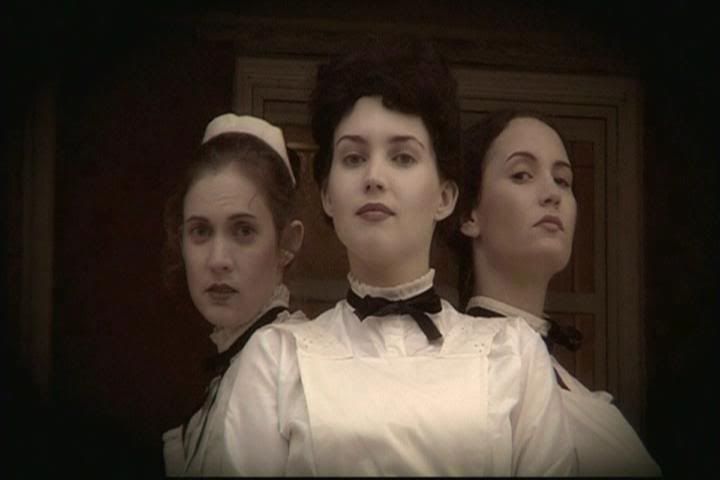 Or is he still drinking the blood? The answer to both is yes. I don't want to explain every facet of it, because I hope to return to it one day, but let's just say in order for him to "harvest" a regular supply of blood, it was necessary for him to hire not ONE maid, but several maids. This was partially inspired by Theodore Sturgeon's novel Some of Your Blood, which was a very sympathetic portrait of a modern vampire. 'Nuff said.
Or is he still drinking the blood? The answer to both is yes. I don't want to explain every facet of it, because I hope to return to it one day, but let's just say in order for him to "harvest" a regular supply of blood, it was necessary for him to hire not ONE maid, but several maids. This was partially inspired by Theodore Sturgeon's novel Some of Your Blood, which was a very sympathetic portrait of a modern vampire. 'Nuff said.
 To me there were clearly overtones added into JH’s story that resonated with Stoker’s Dracula. Was this deliberate and if so what inspired you to add those aspects?
To me there were clearly overtones added into JH’s story that resonated with Stoker’s Dracula. Was this deliberate and if so what inspired you to add those aspects?
 I had read Dracula not long before working on this project, but did not exactly pay homage to Stoker's novel. Instead, little slivers of Dracula appeared as they had been translated by other artists: Orson Welles's 1938 radio broadcast (the use of various documents and points of view), Murnau's Nosferatu (J.H. as a creeping bug), and Tod Browning's 1931 version (J.H.'s three "wives," the idea of men struggling to protect a virgin against the "Other"). My next screenplay has a character who is slightly Renfield-ish... so the Stoker influence is there, I'm just picking it up second-hand.
I had read Dracula not long before working on this project, but did not exactly pay homage to Stoker's novel. Instead, little slivers of Dracula appeared as they had been translated by other artists: Orson Welles's 1938 radio broadcast (the use of various documents and points of view), Murnau's Nosferatu (J.H. as a creeping bug), and Tod Browning's 1931 version (J.H.'s three "wives," the idea of men struggling to protect a virgin against the "Other"). My next screenplay has a character who is slightly Renfield-ish... so the Stoker influence is there, I'm just picking it up second-hand.
 The film looks at many case studies, one particular favourite was the story of Sergeant Bertrand, which you told in the form of a shadow puppet show. What led you to use shadow puppets and how much of a technical challenge was it?
The film looks at many case studies, one particular favourite was the story of Sergeant Bertrand, which you told in the form of a shadow puppet show. What led you to use shadow puppets and how much of a technical challenge was it?
 Originally, the movie was going to be shot in a variety of formats: 35mm, 16mm, Super-8, Digital Video; color, black-and-white, tinted; silent, sound. There was going to be a scene played out by mechanical objects
Originally, the movie was going to be shot in a variety of formats: 35mm, 16mm, Super-8, Digital Video; color, black-and-white, tinted; silent, sound. There was going to be a scene played out by mechanical objects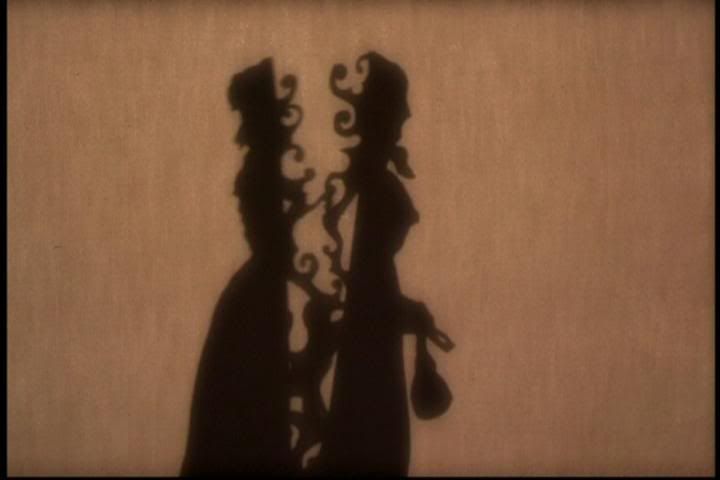 (like some kind of archaic arcade machine). But as we were making the film, I began to have more confidence in my own directing style that I felt like I shouldn't hide behind the different technologies. Plus, with so many stories being told, I realized the film needed more UNITY, rather than diversity. But I had already filmed the puppet show, and it suddenly didn't fit with the rest of the film. In the eleventh hour, I decided to shoot a whole sequence (entirely made up) just to wrap around the shadow puppet sequence. That's where the Divertissement sequence came from.
(like some kind of archaic arcade machine). But as we were making the film, I began to have more confidence in my own directing style that I felt like I shouldn't hide behind the different technologies. Plus, with so many stories being told, I realized the film needed more UNITY, rather than diversity. But I had already filmed the puppet show, and it suddenly didn't fit with the rest of the film. In the eleventh hour, I decided to shoot a whole sequence (entirely made up) just to wrap around the shadow puppet sequence. That's where the Divertissement sequence came from.
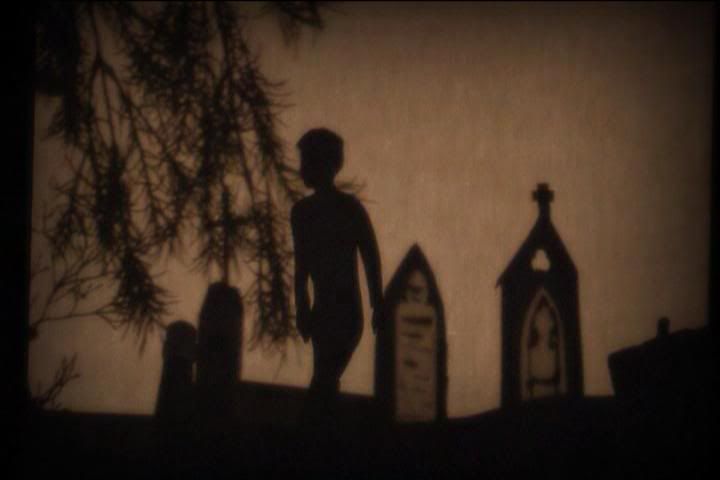 The reason I wanted to shoot the Sergeant Bertrand sequence as a shadow puppet play was, on one level, a way to reference a Victorian method of visual entertainment. I also knew that, no matter what I did, I would never be able to tell the story without it being ridiculous. It involves a boy masturbating as a child while imagining killing women, then mutilating animals, and eventually sexually violating corpses. I didn't want to play it for laughs, or have the whole movie devolve into a gore picture. So the shadow puppet approach served the material extremely well. The sequence was surprisingly simple to shoot. That's because the creation of the puppets was entrusted to Jason Hines, who is a master puppeteer at the world-renowned Center for Puppetry Arts, which happens to be located right here in Atlanta. I thought he might be turned off by the idea of a puppet show about necrophilia, but it turned out he was very excited by the prospect of shooting it. I gave him the narration script and a couple of storyboard sketches. Then he dived into the project, conducted his own research, and came up with the amazing visual devices you see in the film. I just filmed it.
The reason I wanted to shoot the Sergeant Bertrand sequence as a shadow puppet play was, on one level, a way to reference a Victorian method of visual entertainment. I also knew that, no matter what I did, I would never be able to tell the story without it being ridiculous. It involves a boy masturbating as a child while imagining killing women, then mutilating animals, and eventually sexually violating corpses. I didn't want to play it for laughs, or have the whole movie devolve into a gore picture. So the shadow puppet approach served the material extremely well. The sequence was surprisingly simple to shoot. That's because the creation of the puppets was entrusted to Jason Hines, who is a master puppeteer at the world-renowned Center for Puppetry Arts, which happens to be located right here in Atlanta. I thought he might be turned off by the idea of a puppet show about necrophilia, but it turned out he was very excited by the prospect of shooting it. I gave him the narration script and a couple of storyboard sketches. Then he dived into the project, conducted his own research, and came up with the amazing visual devices you see in the film. I just filmed it.
Hines, who has a playful dark side, now goes by the name "Jason von Hinezmeyer." You can view a short film he recently made at You Tube .
 Was there a particular story in the film that you were especially fond of and if so why?
Was there a particular story in the film that you were especially fond of and if so why?
 There are several sequences that I did not get to film, due to financial obstacles and due to my efforts to streamline the stories rather than fragment them. I regret that I didn't get to explore those (some of these appear on the DVD in script form). I'm very fond of all the stories, and very proud of the film, and am frustrated that it didn't find more of an audience upon its initial release. But the movie continues to attract a following of people who appreciate its old-world flavor and early-cinema sensibility, and that's all I ever wanted.
There are several sequences that I did not get to film, due to financial obstacles and due to my efforts to streamline the stories rather than fragment them. I regret that I didn't get to explore those (some of these appear on the DVD in script form). I'm very fond of all the stories, and very proud of the film, and am frustrated that it didn't find more of an audience upon its initial release. But the movie continues to attract a following of people who appreciate its old-world flavor and early-cinema sensibility, and that's all I ever wanted.
 How long did it take you to get from your original conception for the film to the finished product?
How long did it take you to get from your original conception for the film to the finished product?
 We shot Psychopathia over the course of one year, and it took an additional 10 months for post-production. So if you include the writing process, it took about two and a half years.
We shot Psychopathia over the course of one year, and it took an additional 10 months for post-production. So if you include the writing process, it took about two and a half years.
 Were there any particular difficulties that stood in the way of finishing the project?
Were there any particular difficulties that stood in the way of finishing the project?
 The biggest problem was finding locations. Several sequences were to be shot at a sanatorium nearby, built around 1910.
The biggest problem was finding locations. Several sequences were to be shot at a sanatorium nearby, built around 1910. 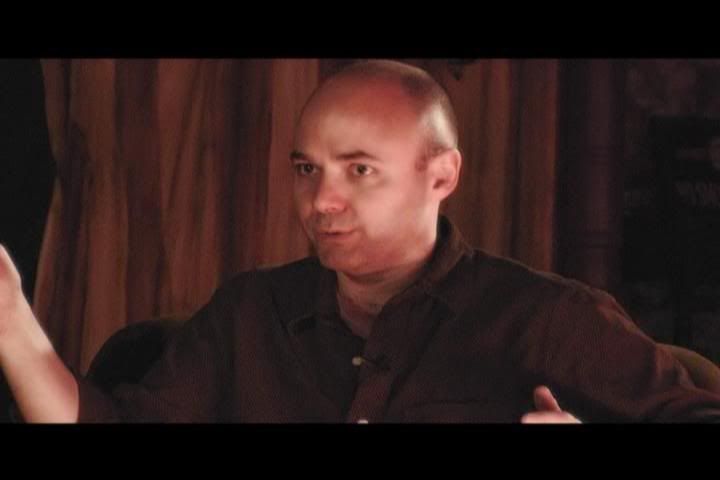 But at the last minute, the city that owns the property refused to let us shoot there, due to the TITLE of our project, which they felt might offend some people. We had another location fall through at the last minute, which required us to find a warehouse space and build sets inside it. Tracy Martin, who produced the film, would not let the project lose steam or fall behind schedule. Anytime there was a problem, she would find some way to carry the film past it. It was she who located the warehouse.
But at the last minute, the city that owns the property refused to let us shoot there, due to the TITLE of our project, which they felt might offend some people. We had another location fall through at the last minute, which required us to find a warehouse space and build sets inside it. Tracy Martin, who produced the film, would not let the project lose steam or fall behind schedule. Anytime there was a problem, she would find some way to carry the film past it. It was she who located the warehouse.
 The film has a strongly Victorian feel, how difficult was it to capture that particular atmosphere?
The film has a strongly Victorian feel, how difficult was it to capture that particular atmosphere?
 We were lucky to find Montgomery Schuth, an extraordinary wig-maker, who was instrumental in helping us achieve a Victorian setting; and Sean Patton, a terrific designer and costumer who was resourceful, tireless and completely dedicated to the project. And numerous scenes were shot in a huge antique store called Paris on Ponce. That was wonderful, because we could improvise sets on the spot by sending someone into their collection to pull whatever we needed to dress the set. And the film owes a lot to Paul Mercer, who composed and (almost single-handedly) performed the score. He had a real affinity for the material, as he is an enthusiast of violins that retain the histories of their owners, so it was a perfect fit.
We were lucky to find Montgomery Schuth, an extraordinary wig-maker, who was instrumental in helping us achieve a Victorian setting; and Sean Patton, a terrific designer and costumer who was resourceful, tireless and completely dedicated to the project. And numerous scenes were shot in a huge antique store called Paris on Ponce. That was wonderful, because we could improvise sets on the spot by sending someone into their collection to pull whatever we needed to dress the set. And the film owes a lot to Paul Mercer, who composed and (almost single-handedly) performed the score. He had a real affinity for the material, as he is an enthusiast of violins that retain the histories of their owners, so it was a perfect fit.
Samples of Mercer's work can be heard at MySpace, both here and here.
 How did the actors react to the material and the setting of the movie?
How did the actors react to the material and the setting of the movie?
 Most people didn't understand exactly what we were aiming for but, to their credit, they trusted us. Only a few actors declined our invitations to be in the film. Almost everyone in the local film community is making the same kind of movies: tongue-in-cheek zombie pictures, mockumentaries, and feel-good family films.
Most people didn't understand exactly what we were aiming for but, to their credit, they trusted us. Only a few actors declined our invitations to be in the film. Almost everyone in the local film community is making the same kind of movies: tongue-in-cheek zombie pictures, mockumentaries, and feel-good family films. 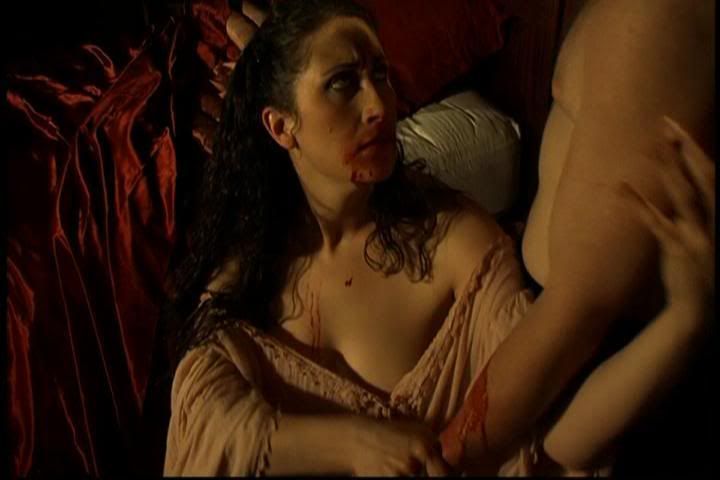 Most of the actors welcomed the opportunity to do something different.
Most of the actors welcomed the opportunity to do something different.
However, they were generally concerned about the sexual content of their scenes -- and with a film called Psychopathia Sexualis, who can blame them? But Tracy and I always thought it was funny -- actors would be happy to chop off heads and shoot people (and have their own heads chopped off) in a film, but when it comes to sex, they get really squeamish.
 Are there any particular on-set anecdotes you’d like to share?
Are there any particular on-set anecdotes you’d like to share?
 Not really. Every day of shooting was an adventure, and I look forward to the time when I'll be able to live through something like that again.
Not really. Every day of shooting was an adventure, and I look forward to the time when I'll be able to live through something like that again.
 Are you content that the final film matches the vision you had? If there were any aspect you could change what would it be?
Are you content that the final film matches the vision you had? If there were any aspect you could change what would it be?
 The film doesn't really match the vision I had -- and that's not a bad thing. As I mentioned before, it was going to be a wild collision of film formats and styles. And the homages to silent film were going to be much more pronounced. But the deeper we got into the shooting schedule, the more Psychopathia started developing a style of its own.
The film doesn't really match the vision I had -- and that's not a bad thing. As I mentioned before, it was going to be a wild collision of film formats and styles. And the homages to silent film were going to be much more pronounced. But the deeper we got into the shooting schedule, the more Psychopathia started developing a style of its own.
It wasn't modern, and it wasn't a retro-silent style either. It was a comfortable hybrid. So instead of forcing a very self-conscious "look" upon the stories, I trusted my own instincts and allowed room for director of photography David Bruckner and gaffer Jonathan Hilton to inject their own ideas into the film. It was a really magical moment to step back from the project, look at it, and discover that I have my own directorial style. That was nice.
Incidentally, d.p. Bruckner is one of the directors of the horror film The Signal, which is already becoming something of a cult sensation, and is being released later this year by Magnolia Pictures. Trailer and info can be found here.
 What project are you working on now? Can you reveal anything about it?
What project are you working on now? Can you reveal anything about it?
 I've just finished a screenplay entitled
I've just finished a screenplay entitled 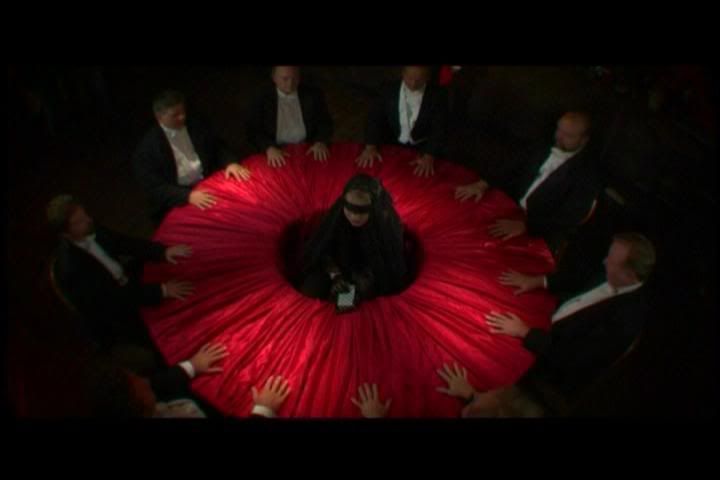 The Seventh Daughter. It actually originated with the Divertissement sequence of Psychopathia. It involves a traveling showman and his young daughter. I returned to the characters in a short film entitled Judgement, which can be viewed here. (NOTE it is also an extra on the Psychopathia sexualis DVD).
The Seventh Daughter. It actually originated with the Divertissement sequence of Psychopathia. It involves a traveling showman and his young daughter. I returned to the characters in a short film entitled Judgement, which can be viewed here. (NOTE it is also an extra on the Psychopathia sexualis DVD).
I was so intrigued by these characters that I made them the focus of their own screenplay. It will no doubt speak the language of silent cinema, with strong influences from William Lindsay Gresham's Nightmare Alley, Tod Browning's The Unholy Three and the psychical research of Albert von Schrenck-Notzing.
 Many thanks for your time.
Many thanks for your time.
The DVD of Psychopathia Sexualis is available in the US from:
In the UK it has not had a region 2 release but can be found on region 1 here:
And can also be found at all good purveyors of Region 1 dvds.
Monday, September 17, 2007
Taliesin Meets… Bret Wood
Posted by
Taliesin_ttlg
at
8:05 AM
![]()
Subscribe to:
Post Comments (Atom)
















No comments:
Post a Comment